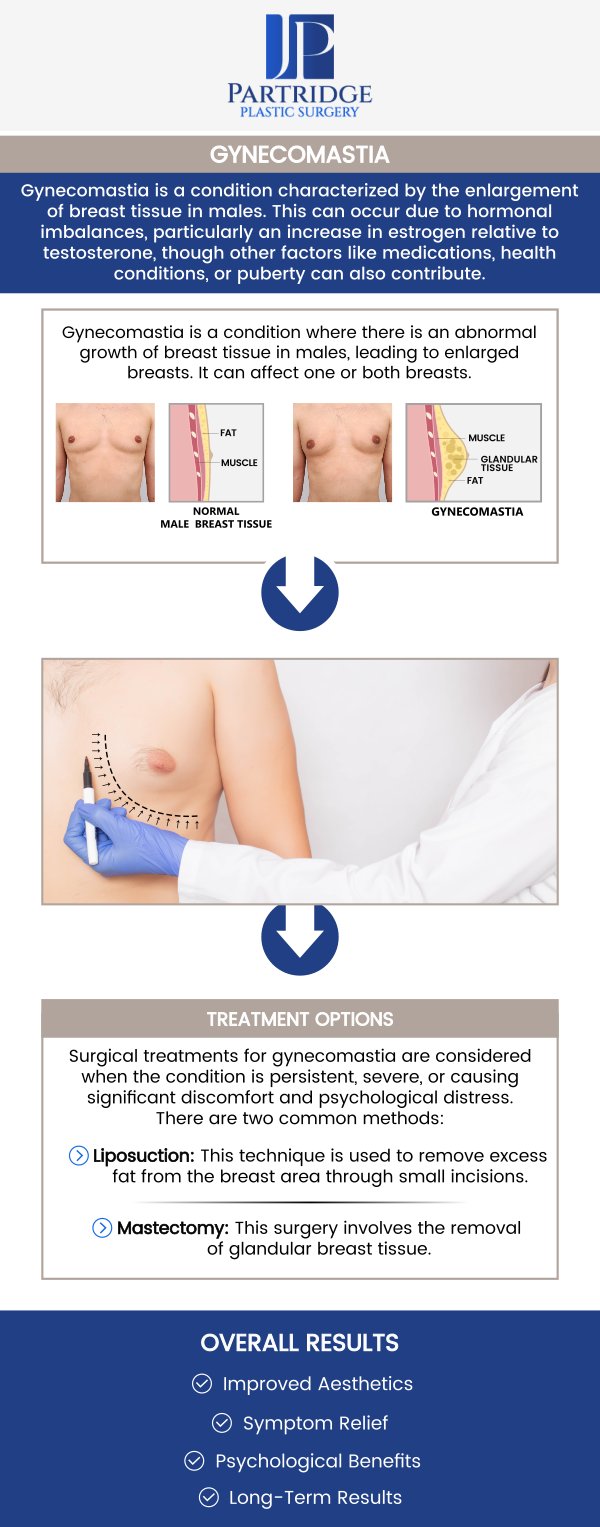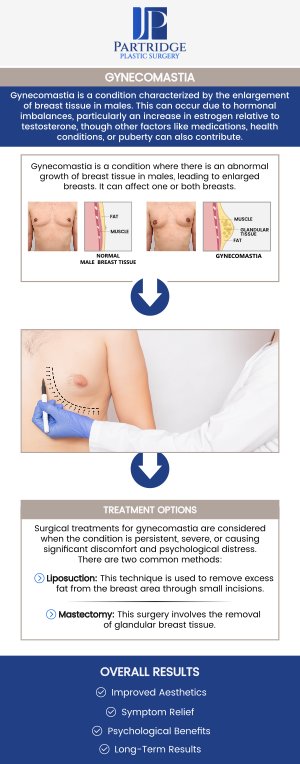Understanding the Causes of Gynecomastia
At Partridge Plastic Surgery, Dr. Joanna Partridge, MD, a board-certified female plastic surgeon, specializes in diagnosing and treating gynecomastia. This condition, characterized by the enlargement of male breast tissue, can occur due to various factors such as hormonal imbalances, genetics, or certain medications. Our team provides comprehensive consultations to help patients understand the underlying causes of their condition and explore effective treatment options tailored to their needs. For more information, contact us today or schedule an appointment online. We have convenient locations to serve you in Princeton, NJ, and North Brunswick, NJ.




Table of Contents:
How can I get rid of gynecomastia?
What is gynecomastia caused by?
What to expect from a male breast reduction?
How do I know if it’s excess breast tissue or fat?
Gynecomastia is a condition characterized by the enlargement of male breasts. It can be hereditary or caused by hormonal imbalance. Men who experience gynecomastia have a larger amount of fatty deposits and breast tissue in the chest. Several treatments can address this concern, but one of the most effective is the surgical treatment of gynecomastia.
Plastic surgeons can utilize a variety of surgical methods to treat gynecomastia and precisely re-contour the chest. The methods used, which may include a variety of different liposuction and excision techniques, will depend upon the quantity and condition of any excess skin that is present as well as the composition of the chest. Patients who have excess fat tissue and good skin elasticity may see optimal results from just liposuction, while patients with loose or sagging skin may need to undergo additional treatments to achieve their desired results. No matter the situation, the plastic surgeon will develop a customized surgical plan designed to meet each patient’s needs and goals while utilizing advanced techniques to minimize the amount of visible scarring.
Gynecomastia is a condition that occurs when there is a decrease in the natural production of testosterone in the body. This disruption causes an imbalance between testosterone and estrogen, leading to an increase in the influence of estrogen on certain physiological functions. When estrogen levels become relatively higher, it can cause the development of excess breast tissue in men, resulting in the enlargement of the breasts.
There are several factors that can contribute to a drop in testosterone levels, which in turn causes gynecomastia. These include puberty, where hormonal fluctuations are common and temporary, aging, which naturally leads to a decrease in testosterone production over time, and obesity, which can affect hormone balance. Additionally, certain medications and underlying health conditions such as hormonal disorders, liver disease, or kidney failure can also contribute to the development of this condition by disrupting the normal balance of hormones in the body.
A male breast reduction procedure typically involves liposuction, which is used to remove excess fat from the breast area. This technique helps reduce the overall size of the breasts and provides a more contoured, masculine appearance. If the enlargement is caused by an overgrowth of glandular tissue, this tissue is also removed to further refine the chest. Liposuction alone can be effective for reducing fat, but the removal of excess glandular tissue ensures a more permanent and balanced result.
In certain cases, the procedure may also involve the removal of excess skin, especially if there is significant sagging or loose skin after the fat and tissue removal. This helps to achieve a smoother, tighter chest contour, preventing any unnecessary skin from hanging loosely. The goal of male breast reduction is not only to reduce the size of the breasts but also to provide a natural-looking, firm, and well-proportioned chest that enhances overall body aesthetics. The combination of techniques ensures the most optimal and satisfying results for patients.
It can be hard to differentiate between breast tissue and fat because they are similar in appearance. The biggest difference between the two is that breast tissue does not go away with a change in diet and regular exercise, often requiring surgical procedures to be removed. An easy way to tell the difference between excess breast tissue or excess fat in the chest is to check for an actual hard lump behind the nipple.
At Partridge Plastic Surgery, Dr. Joanna Partridge, MD, a board-certified cosmetic and reconstructive surgeon, works closely with patients to understand the root causes of this condition. By thoroughly evaluating each patient’s medical history, we help identify the specific cause and offers personalized treatment options to address the condition, ensuring a safe and effective outcome. For more information, contact us today or schedule an appointment online. We have convenient locations in Princeton, NJ and North Brunswick, NJ. We serve patients from Princeton NJ, North Brunswick NJ, Lawrence Township NJ, Pennington NJ, Lawrenceville NJ, New Brunswick NJ, East Brunswick NJ, Highland Park, South Brunswick NJ, and surrounding areas.

Check Out Our 5 Star Reviews


Additional Services You May Need
▸ Breast Augmentation
▸ Breast Lift
▸ Breast Reduction
▸ Breast Reconstruction
▸ Abdominoplasty
▸ Circumferential Body Lift
▸ Arm Lift
▸ Thigh Lift
▸ Buttock Lift
▸ Labiaplasty
▸ Liposuction
▸ Neck Lift
▸ Facelift
▸ Brow Lift
▸ Eyelid Surgery
▸ Fat Injection
▸ Laser Skin Treatments
▸ Injectables
▸ Fat Grafting
▸ Gynecomastia
▸ Abdominal Etching
▸ Reconstructive Surgery

Additional Services You May Need
▸ Breast Augmentation
▸ Breast Lift
▸ Breast Reduction
▸ Breast Reconstruction
▸ Abdominoplasty
▸ Circumferential Body Lift
▸ Arm Lift
▸ Thigh Lift
▸ Buttock Lift
▸ Labiaplasty
▸ Liposuction
▸ Neck Lift
▸ Facelift
▸ Brow Lift
▸ Eyelid Surgery
▸ Fat Injection
▸ Laser Skin Treatments
▸ Injectables
▸ Fat Grafting
▸ Gynecomastia
▸ Abdominal Etching
▸ Reconstructive Surgery








